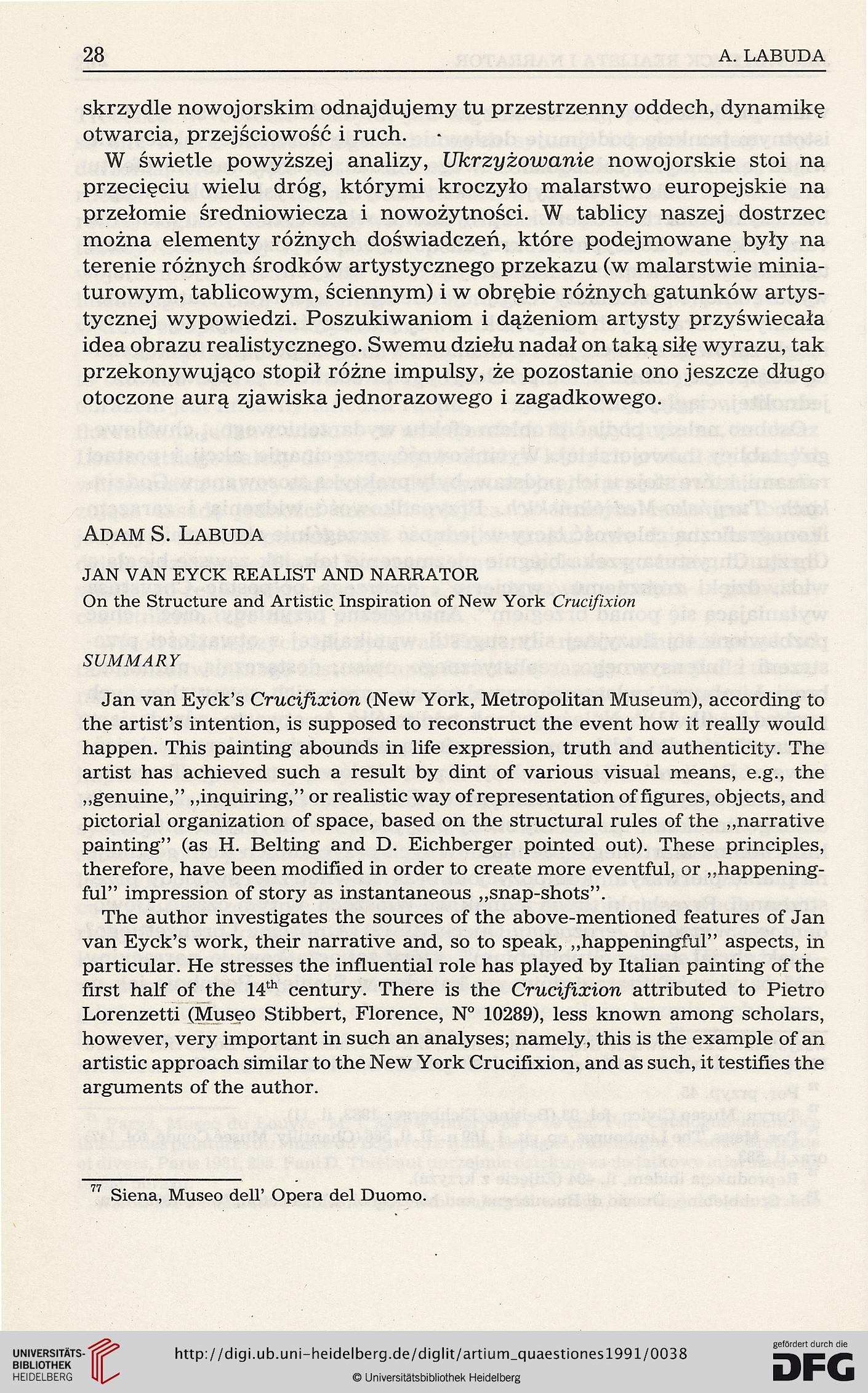28
A. LABUDA
skrzydle nowojorskim odnajdujemy tu przestrzenny oddech, dynamikę
otwarcia, przejściowość i ruch.
W świetle powyższej analizy, UTcrzt/żotuan-ie nowojorskie stoi na
przecięciu wielu dróg, którymi kroczyło malarstwo europejskie na
przełomie średniowiecza i nowożytności. W tablicy naszej dostrzec
można elementy różnych doświadczeń, które podejmowane były na
terenie różnych środków artystycznego przekazu (w malarstwie minia-
turowym, tablicowym, ściennym) i w obrębie różnych gatunków artys-
tycznej wypowiedzi. Poszukiwaniom i dążeniom artysty przyświecała
idea obrazu realistycznego. Swemu dziełu nadał on taką siłę wyrazu, tak
przekonywująco stopił różne impulsy, że pozostanie ono jeszcze długo
otoczone aurą zjawiska jednorazowego i zagadkowego.
ADAM S. LABUDA
JAN VAN EYCK REALIST AND NARRATOR
On the Structure and Artistic Inspiration of New York CrMci/bdcH
-SL/AfAL4RT
Jan van Eyck's Craci/tadow (New York, Metropolitan Museum), according to
the artist's intention, is supposed to reconstruct the event how it really would
happen. This painting abounds in life expression, truth and authenticity. The
artist has achieved such a result by dint of various visual means, e.g., the
„genuine," „inquiring," or realistic way of representation of figures, objects, and
pictorial organization of space, based on the structural rules of the „narrative
painting" (as H. Belting and D. Eichberger pointed out). These principles,
therefore, have been modified in order to create more eventful, or „happening-
ful" impression of story as instantaneous „snap-shots".
The author investigates the sources of the above-mentioned features of Jan
van Eyck's work, their narrative and, so to speak, „happeningful" aspects, in
particular. He stresses the influential role has played by Italian painting of the
first half of the 14"* century. There is the Crttci/lariow attributed to Pietro
Lorenzetti (Museo Stibbert, Florence, N° 10289), less known among scholars,
however, very important in such an analyses; namely, this is the example of an
artistic approach similar to the New York Crucifixion, and as such, it testifies the
arguments of the author.
77
Siena, Museo dell' Opera del Duomo.
A. LABUDA
skrzydle nowojorskim odnajdujemy tu przestrzenny oddech, dynamikę
otwarcia, przejściowość i ruch.
W świetle powyższej analizy, UTcrzt/żotuan-ie nowojorskie stoi na
przecięciu wielu dróg, którymi kroczyło malarstwo europejskie na
przełomie średniowiecza i nowożytności. W tablicy naszej dostrzec
można elementy różnych doświadczeń, które podejmowane były na
terenie różnych środków artystycznego przekazu (w malarstwie minia-
turowym, tablicowym, ściennym) i w obrębie różnych gatunków artys-
tycznej wypowiedzi. Poszukiwaniom i dążeniom artysty przyświecała
idea obrazu realistycznego. Swemu dziełu nadał on taką siłę wyrazu, tak
przekonywująco stopił różne impulsy, że pozostanie ono jeszcze długo
otoczone aurą zjawiska jednorazowego i zagadkowego.
ADAM S. LABUDA
JAN VAN EYCK REALIST AND NARRATOR
On the Structure and Artistic Inspiration of New York CrMci/bdcH
-SL/AfAL4RT
Jan van Eyck's Craci/tadow (New York, Metropolitan Museum), according to
the artist's intention, is supposed to reconstruct the event how it really would
happen. This painting abounds in life expression, truth and authenticity. The
artist has achieved such a result by dint of various visual means, e.g., the
„genuine," „inquiring," or realistic way of representation of figures, objects, and
pictorial organization of space, based on the structural rules of the „narrative
painting" (as H. Belting and D. Eichberger pointed out). These principles,
therefore, have been modified in order to create more eventful, or „happening-
ful" impression of story as instantaneous „snap-shots".
The author investigates the sources of the above-mentioned features of Jan
van Eyck's work, their narrative and, so to speak, „happeningful" aspects, in
particular. He stresses the influential role has played by Italian painting of the
first half of the 14"* century. There is the Crttci/lariow attributed to Pietro
Lorenzetti (Museo Stibbert, Florence, N° 10289), less known among scholars,
however, very important in such an analyses; namely, this is the example of an
artistic approach similar to the New York Crucifixion, and as such, it testifies the
arguments of the author.
77
Siena, Museo dell' Opera del Duomo.





